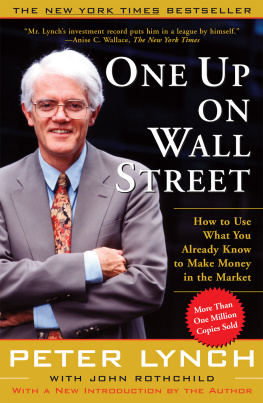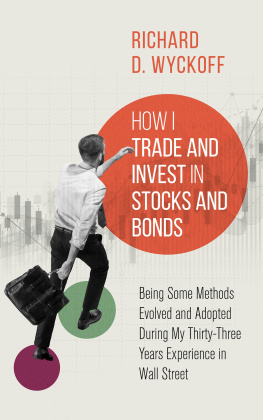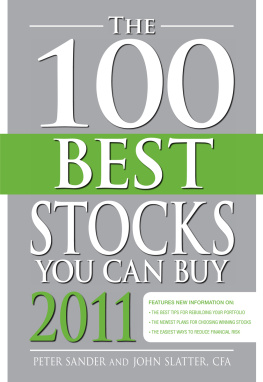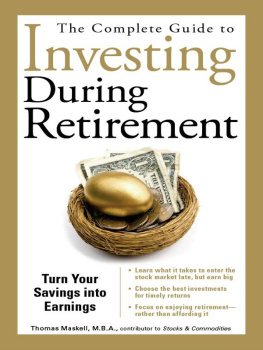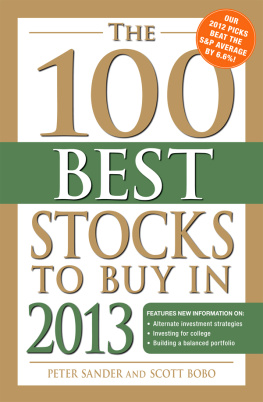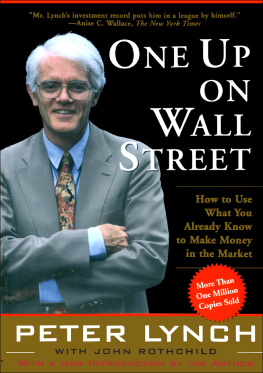Thank you for downloading this Simon & Schuster eBook.
Join our mailing list and get updates on new releases, deals, bonus content and other great books from Simon & Schuster.
C LICK H ERE T O S IGN U P
or visit us online to sign up at
eBookNews.SimonandSchuster.com
We hope you enjoyed reading this Simon & Schuster eBook.
Join our mailing list and get updates on new releases, deals, bonus content and other great books from Simon & Schuster.
C LICK H ERE T O S IGN U P
or visit us online to sign up at
eBookNews.SimonandSchuster.com
Contents
To Carolyn, my wife and best friend for over twenty years, whose support and sacrifices have been critically important to me.
To my children, Mary, Annie, and Beth, whose love for each other and their parents has meant so very much.
To my colleagues at Fidelity Investments, whose extra efforts have made Magellans performance possible but who have received none of the favorable publicity.
To one million shareholders in Magellan, who have entrusted their savings to me and who have sent thousands of letters and made thousands of calls over the years, comforting me during declines in the market and reminding me that the future will be fine.
To Holy God for all the incredible blessings I have been given in my life.
Introduction to the Millennium Edition
This book was written to offer encouragement and basic information to the individual investor. Who knew it would go through thirty printings and sell more than one million copies? As this latest edition appears eleven years beyond the first, Im convinced that the same principles that helped me perform well at the Fidelity Magellan Fund still apply to investing in stocks today.
Its been a remarkable stretch since One Up on Wall Street hit the bookstores in 1989. I left Magellan in May, 1990, and pundits said it was a brilliant move. They congratulated me for getting out at the right timejust before the collapse of the great bull market. For the moment, the pessimists looked smart. The countrys major banks flirted with insolvency, and a few went belly up. By early fall, war was brewing in Iraq. Stocks suffered one of their worst declines in recent memory. But then the war was won, the banking system survived, and stocks rebounded.
Some rebound! The Dow is up more than fourfold since October, 1990, from the 2,400 level to 11,000 and beyondthe best decade for stocks in the twentieth century. Nearly 50 percent of U.S. households own stocks or mutual funds, up from 32 percent in 1989. The market at large has created $25 trillion in new wealth, which is on display in every city and town. If this keeps up, somebody will write a book called The Billionaire Next Door.
More than $4 trillion of that new wealth is invested in mutual funds, up from $275 billion in 1989. The fund bonanza is okay by me, since I managed a fund. But it also must mean a lot of amateur stockpickers did poorly with their picks. If theyd done better on their own in this mother of all bull markets, they wouldnt have migrated to funds to the extent they have. Perhaps the information contained in this book will set some errant stockpickers on a more profitable path.
Since stepping down at Magellan, Ive become an individual investor myself. On the charitable front, I raise scholarship money to send inner-city kids of all faiths to Boston Catholic schools. Otherwise, I work part-time at Fidelity as a fund trustee and as an adviser/trainer for young research analysts. Lately my leisure time is up at least thirtyfold, as I spend more time with my family at home and abroad.
Enough about me. Lets get back to my favorite subject: stocks. From the start of this bull market in August 1982, weve seen the greatest advance in stock prices in U.S. history, with the Dow up fifteenfold. In Lynch lingo thats a fifteenbagger. Im accustomed to finding fifteenbaggers in a variety of successful companies, but a fifteenbagger in the market at large is a stunning reward. Consider this: From the top in 1929 through 1982, the Dow produced only a fourbagger: up from 248 to 1,046 in a half century! Lately stock prices have risen faster as theyve moved higher. It took the Dow 81/3 years to double from 2,500 to 5,000, and only 31/2 years to double from 5,000 to 10,000. From 199599 we saw an unprecedented five straight years where stocks returned 20 percent plus. Never before has the market recorded more than two back-to-back 20 percent gains.
Wall Streets greatest bull market has rewarded the believers and confounded the skeptics to a degree neither side could have imagined in the doldrums of the early 1970s, when I first took the helm at Magellan. At that low point, demoralized investors had to remind themselves that bear markets dont last forever, and those with patience held on to their stocks and mutual funds for the fifteen years it took the Dow and other averages to regain the prices reached in the mid-1960s. Today its worth reminding ourselves that bull markets dont last forever and that patience is required in both directions.
On its the Internet, and so far the Internet has passed me by. All along Ive been technophobic. My experience shows you dont have to be trendy to succeed as an investor. In fact, most great investors I know (Warren Buffett, for starters) are technophobes. They dont own what they dont understand, and neither do I. I understand Dunkin Donuts and Chrysler, which is why both inhabited my portfolio. I understand banks, savings-and-loans, and their close relative, Fannie Mae. I dont visit the Web. Ive never surfed on it or chatted across it. Without expert help (from my wife or my children, for instance) I couldnt find the Web.
Over the Thanksgiving holidays in 1997, I shared eggnog with a Web-tolerant friend in New York. I mentioned that my wife, Carolyn, liked the mystery novelist Dorothy Sayers. The friend sat down at a nearby computer and in a couple of clicks pulled up the entire list of Sayers titles, plus customer reviews and the one- to five-star ratings (on the literary Web sites, authors are rated like fund managers). I bought four Sayers novels for Carolyn, picked the gift wrapping, typed in our home address, and crossed one Christmas gift off my list. This was my introduction to Amazon.com.
Later on youll read how I discovered some of my best stocks through eating or shopping, sometimes long before other professional stock hounds came across them. Since Amazon existed in cyberspace, and not in suburban mall space, I ignored it. Amazon wasnt beyond my comprehensionthe business was as understandable as a dry cleaners. Also, in 1997 it was reasonably priced relative to its prospects, and it was well-financed. But I wasnt flexible enough to see opportunity in this new guise. Had I bothered to do the research, I would have seen the huge market for this sort of shopping and Amazons ability to capture it. Alas, I didnt. Meanwhile, Amazon was up tenfold (a tenbagger in Lynch parlance) in 1998 alone.
Amazon is one of at least five hundred dot.com stocks that have performed miraculous levitations. In high-tech and dot.com circles, its not unusual for a newly launched public offering to rise tenfold in less time than it takes Stephen King to pen another thriller. These investments dont require much patience. Before the Internet came along, companies had to grow their way into the billion-dollar ranks. Now they can reach billion-dollar valuations before theyve turned a profit or, in some cases, before theyve collected any revenues. Mr. Market (a fictional proxy for stocks in general) doesnt wait for a newborn Web site to prove itself in real life the way, say, Wal-Mart or Home Depot proved themselves in the last generation.
Next page
